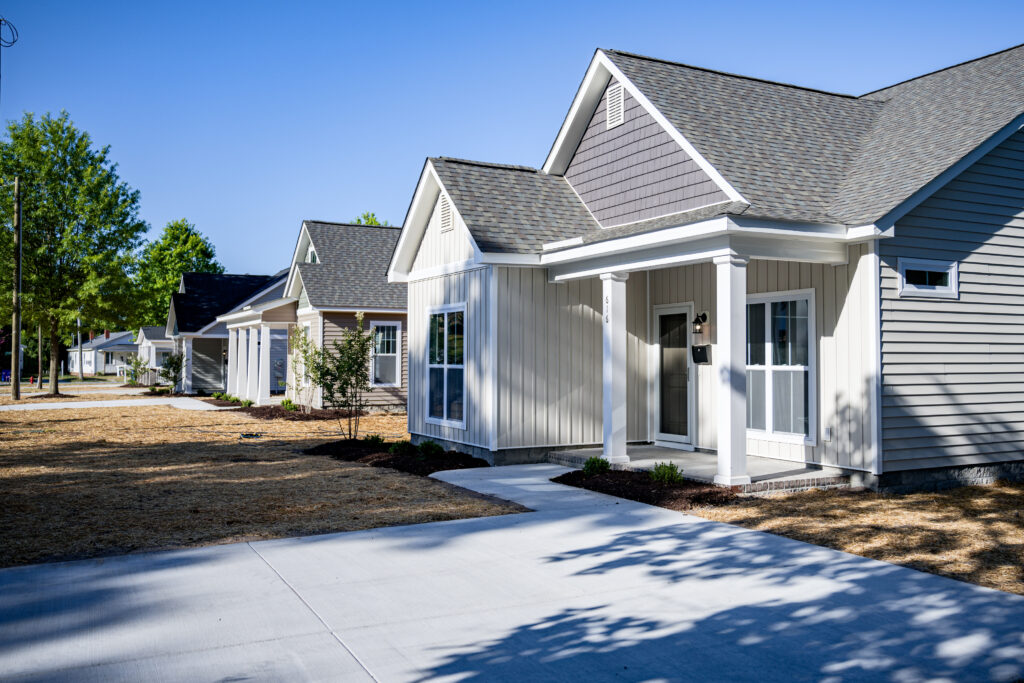
News
By Michael Rodriguez, October 15, 2025
We’re short 4.7 million homes. Our approach to housing aims to build more homes in the right places at the right price so that everyone can live in a community that supports them at every stage of life.
But what do we mean by the right price? In this series of explainer blogs, we’re taking a closer look at how, in addition to focusing on supply, smart growth strategies on type, place, and price are essential to solving the housing crisis and creating the types of homes and communities that allow people to stay, grow, and thrive.

The obvious point about housing is that price matters a lot. It is the single biggest expense for most households, and for many, the biggest constraint on where they can live. Yet price remains one of the least understood parts of our housing system. Too often, it is treated as a natural outcome of “the market” rather than something shaped by policy, finance, and planning choices.
And unlike bidding the lowest price without going over, the price of housing often isn’t right, Bob (or Drew for you younger folks). For millions of families, the numbers simply do not add up: rents climb faster than paychecks, homeownership drifts out of reach, and entire communities struggle under the weight of housing costs.
If we are serious about solving the housing crisis, we have to start here. It is where zoning rules, financing tools, land costs, and household budgets all converge, resulting in real impacts on everyone’s daily life. Understanding how pricing works and how we can influence it is essential if we want to create more homes in the right places at prices people can actually afford.
What we mean when we talk about price
When we talk about housing prices, we are talking about more than a listing number on Zillow or the rent posted on a flyer. For renters, price means monthly rent plus utilities, parking, fees, and the costs of time and transportation to simply get to work, school, or groceries from that home. For homeowners, it includes mortgage payments, property taxes, insurance, maintenance, and interest rates that can double or halve purchasing power. Right now, nearly half of all renters and more than one in four homeowners are cost-burdened, meaning that they spend more than 30 percent of their income on housing.
In communities, price shows up in the fiscal costs of extending infrastructure like roads, sewers, or pipes to developments miles from existing services. However, unlike the prices of groceries or gas, housing costs do not fluctuate simply with global markets. They are largely the product of local decisions: what we allow to be built, where we allow it, and how we finance it.
Our struggle with simple supply and demand
Housing price is a reflection of supply and demand, but with a unique twist: land constraints, location dynamics, and a market with substantial policy interventions from every level of government.
On the demand side, we know that more people want to live near jobs, schools, amenities, and transit. Walkable, connected neighborhoods command a premium because they save time, reduce car dependence, and support quality of life. SGA’s Foot Traffic Ahead report shows that walkable urban places generate outsized economic activity and higher real estate values. People are not irrational for paying more to live in them; they are paying for convenience, connection, and opportunity.
On the supply side, decades of restrictive zoning, lengthy permitting processes, and unpredictable approval systems have made it harder to produce housing efficiently. As our Center for Zoning Solutions discusses, many local codes still ban or discourage multifamily buildings, small lot homes, or accessory dwelling units, artificially constraining the number of homes in the places people most want to live.
The clear imbalance between rising demand and restricted supply is the fundamental driver of high housing costs. Add the limitations on the types of homes available and where they’re located, and prices climb higher or sprawl continues. When insufficient supply becomes a feature of the market, prices can and will only go one way—up. Without getting too academic, these are forces already discussed at length by the Standard Urban Model of economics (price increases with centrality), and the Amenity Model (aka the Spatial Equilibrium Model, where price increases with local amenities). While this may come as no surprise to those in the weeds of the affordability crisis, these points are relevant to anyone who cares about housing costs.
Financing and macroeconomics matter too. Historically low interest rates in the 2010s boosted purchasing power and helped fuel price spikes. Investor activity—and therefore, vacant homes—and short-term rentals have tightened markets further in certain cities. Then, as interest rates rose again in recent years, monthly costs soared even when nominal home prices leveled off. More owners are deciding to keep their homes with low-interest-rate mortgages rather than moving to a place that better suits their needs, but with higher interest rates. The result? A further reduction in the supply of units on the market, influencing both the for-sale housing market and rents (the two are linked). These trends show that housing affordability is not just a planning issue but a structural economic one.
To recap, there is a tangle of structural and policy choices that make homes more expensive than they need to be. Restrictive zoning limits where and what can be built, keeping land scarce and prices high. Building on the edges instead of within existing neighborhoods forces cities to extend infrastructure farther and maintain it longer, with costs that ultimately fall on households while depriving them of popularly-demanded housing options. Material and labor shortages, coupled with long permitting timelines and complex financing requirements, make new housing harder and more expensive to deliver. Vacant land, underutilized public properties and commercial properties, and tax systems that discourage reinvestment further compound the problem. None of this is inevitable. It is all the outcome of decisions made decades ago, and others reaffirmed every time a community chooses scarcity over abundance.
How we can address the price problem
How we can address the price problem
Some of the most effective price interventions begin with reforming outdated rules, allowing the market to respond to demand (a theme that our Center for Zoning Solutions consistently helps communities with). Allowing a broader range of housing types like small multifamily buildings, accessory units, and missing middle options can lower per-unit land costs and expand choices for households at different income levels. Streamlined, predictable approval processes reduce the uncertainty that drives up financing costs. Eliminating unnecessary requirements, like excessive parking mandates, can save tens of thousands of dollars per unit.
Beyond rules, rethinking land and financing is equally important. Redeveloping publicly owned or underutilized land for mixed-income housing leverages existing infrastructure and lowers the public cost of new development. Infill and transit-oriented projects allow more people to live near the jobs and amenities that drive demand in the first place. Innovative financing, whether through low-interest federal tools, state housing funds, or revolving acquisition loans, helps mission-driven and smaller developers compete in a system often tilted toward the largest players.
At the same time, targeted affordability tools such as the Low-Income Housing Tax Credit (LIHTC), housing vouchers, and inclusionary zoning remain essential for reaching households that the market alone will not serve. These programs bridge the gap between wages and rents while encouraging long-term affordability through shared-equity models, community land trusts, and preservation of naturally affordable homes.
Taken together, these approaches illustrate how SGA’s work across Type, Place, and Price converges: better rules create more housing types, efficient land use ensures the places we build make sense for people and the planet, and sound financial and policy tools help bring prices back within reach.
Bringing price into balance
When prices are out of balance, everything else is, too. Workers are forced to move farther from jobs, families spend more of their income on transportation, and communities lose the diversity that makes them vibrant. But when prices stabilize, opportunity expands. Employers can attract talent, seniors can age in place, and young people can envision a future in their hometowns. Lower housing costs not only strengthen individual households but also strengthen the economic fabric of entire regions.
SGA’s approach here is simple but ambitious: more homes, at prices people can afford, in places that make sense for people at every stage of life. Price is the thread that connects our housing goals to our broader mission of equitable, sustainable growth. Addressing it means confronting the policies and assumptions that have made scarcity our default. It means recognizing that affordability is not a mystery of the market but a reflection of the rules we set and the investments we make.
Right now, when it comes to housing, the price isn’t right, and it has not been for a long time. Unlike the TV show, there is no big wheel to spin or lucky guess to make this better. Addressing the housing crisis takes intentional policy, smarter planning, and a commitment to abundance over scarcity.
And if we can do that, then maybe everyone wins something far better than a vacation to Cabo: a stable home, a thriving neighborhood, and a fair shot at living where opportunity lives too.
Related News

© 2025 Smart Growth America. All rights reserved
Site By3Lane Marketing
















